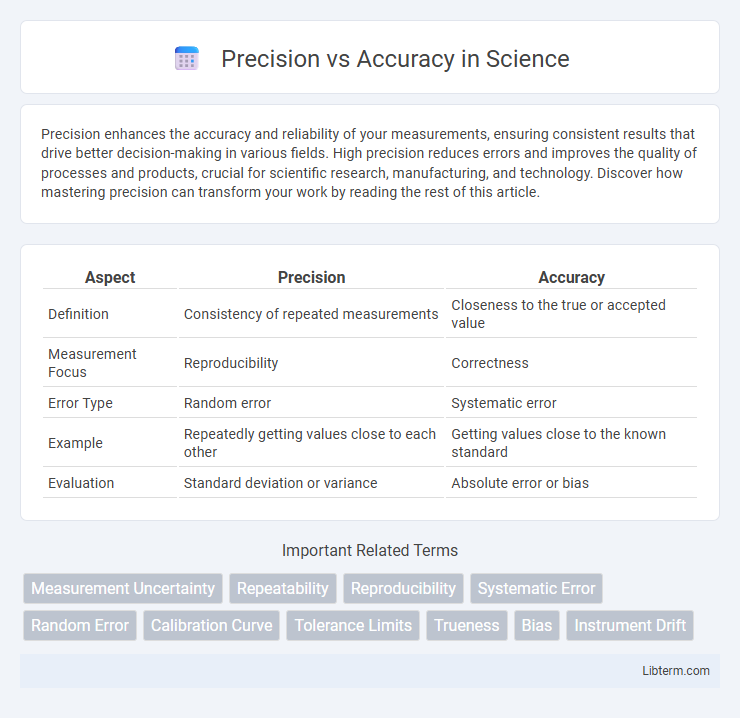Precision enhances the accuracy and reliability of your measurements, ensuring consistent results that drive better decision-making in various fields. High precision reduces errors and improves the quality of processes and products, crucial for scientific research, manufacturing, and technology. Discover how mastering precision can transform your work by reading the rest of this article.
Table of Comparison
| Aspect | Precision | Accuracy |
|---|---|---|
| Definition | Consistency of repeated measurements | Closeness to the true or accepted value |
| Measurement Focus | Reproducibility | Correctness |
| Error Type | Random error | Systematic error |
| Example | Repeatedly getting values close to each other | Getting values close to the known standard |
| Evaluation | Standard deviation or variance | Absolute error or bias |
Understanding Precision and Accuracy
Precision refers to the consistency of repeated measurements, indicating how closely data points cluster together, while accuracy measures how close a measurement is to the true or accepted value. High precision can occur without accuracy if measurements are consistently off-target, whereas high accuracy requires measurements to be both close to the true value and consistent. Understanding the distinction between precision and accuracy is crucial in fields like scientific research, engineering, and quality control to ensure reliable and valid results.
Defining Key Terms
Precision refers to the consistency or repeatability of measurements, indicating how closely multiple results align with each other. Accuracy measures how close a measurement is to the true or accepted value, reflecting correctness. Understanding the distinction between precision and accuracy is essential in fields like metrology, statistics, and quality control to evaluate data reliability and validity.
The Core Differences Explained
Precision refers to the consistency of repeated measurements, indicating how close data points are to each other, while accuracy measures how close a measurement is to the true or accepted value. A high-precision result may lack accuracy if it consistently deviates from the correct value, whereas high accuracy indicates correctness regardless of measurement variability. Understanding these core differences is essential in fields like scientific research and quality control for interpreting data reliability effectively.
Importance in Scientific Measurements
Precision in scientific measurements ensures consistent reproducibility of results, while accuracy guarantees that these results closely reflect true values. High precision without accuracy can lead to systematically skewed data, compromising the validity of experiments. Emphasizing both precision and accuracy is critical for reliable data interpretation, quality control, and advancing scientific knowledge.
Precision vs Accuracy in Everyday Life
Precision in everyday life measures the consistency of repeated actions, such as consistently hitting the same spot when throwing darts, while accuracy reflects how close those actions are to the intended target. For example, a driver maintaining a steady speed is displaying precision, but driving at the correct speed limit demonstrates accuracy. Understanding the difference helps improve tasks from cooking recipes to managing finances by emphasizing either consistent results or meeting specific goals.
Common Misconceptions
Many people confuse precision with accuracy, assuming the terms are interchangeable; however, precision refers to the consistency of repeated measurements, while accuracy indicates how close measurements are to the true value. A common misconception is believing that a highly precise dataset is necessarily accurate, yet precise results can be systematically off-target if there is bias or calibration error. Understanding the distinction helps in interpreting scientific data and improving measurement reliability.
Practical Examples and Case Studies
Precision refers to the consistency of repeated measurements, exemplified by a laboratory scale that consistently weighs a sample as 10.2 grams, even if slightly off from the true weight. Accuracy denotes how close a measurement is to the true value, such as a GPS system that locates a position within a few meters of its actual coordinates. Case studies in manufacturing show that high precision without accuracy can lead to consistently defective products, whereas balancing both ensures reliable quality control and customer satisfaction.
Improving Measurement Quality
Improving measurement quality requires understanding the distinction between precision and accuracy, where precision refers to the consistency of repeated measurements, and accuracy signifies how close measurements are to the true value. Enhancing precision involves minimizing random errors through calibrated instruments and standardized procedures, while improving accuracy demands reducing systematic errors by thorough equipment validation and environmental control. Employing statistical analysis and regular quality control checks ensures both high precision and accuracy, leading to reliable and valid measurement results in scientific and industrial applications.
Tools and Techniques for Assessment
Precision in measurement reflects the consistency of repeated results using tools like calipers and micrometers, which minimize variability through high-resolution scales and stable calibration. Accuracy depends on properly calibrated instruments and validated techniques such as gauge block standards and interferometry, ensuring measurements closely match the true value. Advanced assessment methods combine statistical analysis software with automated measurement systems to evaluate both precision and accuracy in industrial quality control.
Conclusion: Striking the Right Balance
Achieving optimal results requires a balanced emphasis on both precision and accuracy, as relying solely on one compromises data reliability and validity. Precision ensures consistent repeatability of measurements, while accuracy guarantees closeness to the true value, making their synergy essential for credible outcomes. Striking the right balance enhances decision-making processes across scientific research, manufacturing, and quality control sectors.
Precision Infographic

 libterm.com
libterm.com